drkhalsa
SPNer
- Sep 16, 2004
- 1,308
- 54
Freemason’s confidential code Once a secret brotherhood, the Freemasonry of the Holy City, set up even before the SGPC came into existence, is now ready for change. Varinder Walia gets behind the cloaked chambers
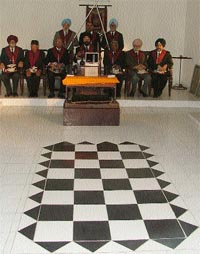
The Freemasons of Amritsar during a meeting in the Lodge on Ajnala Road. — Photos by Rajiv Sharma
Until recently, not much was known about the activities of Freemasonry as the Lodges (meeting places) used to maintain total secrecy. Of late, Freemasonry has been coming out in the open to attract members into its fold by clearing doubts about the movement.
Freemasonry claims itself to be one of the world’s oldest secular fraternal societies. It is a worldwide organisation based on the principle of the Fatherhood of God and the Brotherhood of man. It is a society exclusively of men-folk concerned with moral and spiritual values. Its members are taught its precepts by series of rituals, which follow ancient forms and use stone masons’ customs and tools, and allegorical guides.
Freemasonry neither instruct its members on what their religious beliefs should be, nor that theirs is a substitute for religion.
Just like any other club, Freemasons have a dress code at their meetings. The members wear aprons and regalia, considered a traditional and ceremonial recognition within the brotherhood.
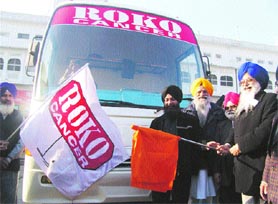
Avtar Singh Makkar, President, SGPC, flags off the ROKO Cancer mobile van, launched in collaboration with Freemasoners.
However, it emphasises secularism by teaching respect for and tolerance towards all religions. There are many churchgoers— Sikhs and Hindus— who feel they can be both an active Freemason and simultaneously have full faith in their own religions. The holy books of the Freemasons include abstracts from Guru Granth Sahib, Quran, Bhagwat Gita, Bible and Zend Avista (the holy book of the Parsis). The Masonic tools inside the Holy Books are also opened at the time of meetings.
The Freemasonry was established in 1922 at Amritsar, three years before the establishment of the Shiromani Gurdwara Prabandhak Committee. Its first master was Gurdit Singh Arora, a prominent business tycoon of the Holy City.
However, since 83 years of its inception, the strength of the brotherhood is only 40, mostly the elite of the city. The reason for little strength is a person is made a member only after his name is recommended by a mason. A secret ballot is used for inducting anybody into the Freemasonry here. Black and white balls are used to select or reject a person. Two black balls are enough to disqualify any person from becoming a mason.
Most of the members are prominent doctors of the city, and also include former principles of the Government Medical College, senior lawyers and business tycoons.
The oldest living past masters of the Freemasonry in Amritsar are Dr Ranbir Singh (87), Mr Inderjit Sud (86), Mr K.J. Arora (86), Mr O.P. Mehra (84), his son Mr Naval Mehra (53), Dr M.S. Khanna (60), and Dr P.S. Grewal (86).
Interestingly, the president of Chief Khalsa Diwan, the oldest Sikh institute, has also been a Master of the Freemasonry.
Initially, the people of Amritsar would call the Freemasons as “The Jadugar” (The Magicians). The impression used for the Mumbai Lodge as “Bhoot Bungalow” has also dispelled.
But the Freemasons are unique. Their singular style of handshaking and other codes still help them to maintain their identity.
Mr Inderjit Sud, one of the oldest members of the Freemasonry here, said he has been associated with the society for more than four decades. “The codes help me in entering the different Freemasonry Lodges in America. I was put to test every time I wanted to secure an entry into the Lodges of USA. It were the codes that helped them to identify me as a mason.” Mr Sud said the masons developed such codes in ancient times. “They built great temples and architectural wonders with a view to stop the entry of intruders.”
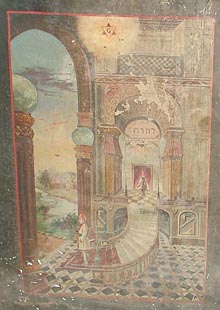
One of the several degrees a Freemason has to pass to become a permanent member. The next are shown below.
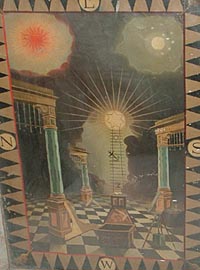 Morality matters
Morality matters
No atheist can become a Mason. Anyone who is of a good moral character and believes in the existence of the Almighty God and in the Supreme Being, no matter by what name He is called, or what faith the person professes, is eligible.
Rituals are an integral and unique part of Masonic traditions. It employs stonemason’s tools as symbols to communicate the principles of Freemasonry to the candidate to explain its philosophy to him.
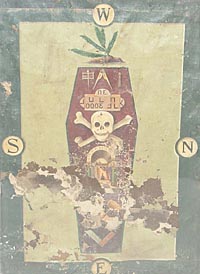
Dr Santokh Singh, another past master claimed that lately the Freemasonry has embarked upon large charitable projects; prominent among them the ROKO Cancer. The mobile van for the project was launched by Mr Avtar Singh Makkar, president of the SGPC.
The origins of Freemasonry are shrouded in mystery, largely because the members have kept it a secret. An introduction to Freemasonry in India reads, “Perhaps it can be said that of all the mysteries of Freemasonry, there is perhaps no mystery more mysterious than the origin of Freemasonry.” However, Freemasonry in an organised form started in 1717. But the real origins of Freemasonry, is hidden and lost in the mists of time.
In fact, Freemasonry itself is profoundly uncertain of its origins, the general assumption being that it began at a time when King Solomon’s Temple was built in Jerusalem. This is an accepted legend and Freemasons consider King Solomon as their First Grand Master .
Allegorical symbols are the hallmark of Freemasonry. Wearing of regalia that include badges and emblems, aprons, uniforms, sashes, gloves, hats, medals, and swords during the meetings is fascinating, say the members.
Floor cloths and charts used during the initiation of candidates are a good place to begin the investigation of the material culture of Freemasonry.
Within the prescribed oblong indented border can be found the all-seeing eye, the crescent moon, and seven stars. The black and white checkered floor representing the floor of the King Solomon’s Temple leads to one, two, or three steps representing various degree levels. Stonemasons’ working tools such as the square, compass, plumb rule, level, chisel, mallet, and trowel are distributed around the periphery, along with additional symbols representing specific degrees. Other symbols that are not considered tools appear in lodges as well.
Explaining the past history of the Amritsar Lodge, Dr Parmjit Singh Grewal, its secretary, and also a past Master says, “In the beginning, meetings of the Freemasonry used to be held at Maharaja Ranjit Singh’s summer palace at Ram Bagh Garden once a month for few years. After about 45 years, the government got the meeting hall vacated and converted it into a museum and the Freemasonry became homeless. Thereafter the meetings were held at places like schools and the members’ residences.” In year 2000, Dr Santokh Singh donated a plot of 500 square yards at his farmhouse on the Ajnala Road for the construction of a Freemasons Hall (Temple). The hall was constructed with a handsome contribution from the Grand Lodge of India and the regional Grand Lodge of North India along with contributions from the members of the Lodge. The hall was dedicated to the great architect of the universe (God) by the Grand Master of India in 2002. The Lodge meetings are held in this hall ever since. Some of the prominent and dedicated freemason includes of Amritsar include Dr Sohan Singh, a famous eye surgeon of his time who is said to have performed the maximum number of cataract operations, Dr Guranditta Kapoor (Rai Sahib), Dr Gurmukh Singh Chawla, Mr Sant Singh, a former president of Chief Khalsa Diwan, Mr Gurcharn Singh, Dr K.S. Grewal, Dr Pritam Singh, Mr Hardit Singh Makhni, Thakur Das Mehra, Mr Beant Singh, Dr M.S. Khanna, S. Sant Singh, president of the Chief Khalsa Diwan for a number of years, Mr R.A . Boga, an industrialist and a philanthropist, Dr Karm Singh Grewal, a famous orthopedic surgeon, Mr G.R. Sethi, a journalist, and Dr Pritam Singh, former principal of the Medical College, Dr S.S. Manchanda, a well-known child specialist, Dr D.P. Savan, a surgeon, Dr Avtar Singh, a gynecologist, Lal Chand Mehra and Mr Labh Chand Mehra.

The Freemasons of Amritsar during a meeting in the Lodge on Ajnala Road. — Photos by Rajiv Sharma
Until recently, not much was known about the activities of Freemasonry as the Lodges (meeting places) used to maintain total secrecy. Of late, Freemasonry has been coming out in the open to attract members into its fold by clearing doubts about the movement.
Freemasonry claims itself to be one of the world’s oldest secular fraternal societies. It is a worldwide organisation based on the principle of the Fatherhood of God and the Brotherhood of man. It is a society exclusively of men-folk concerned with moral and spiritual values. Its members are taught its precepts by series of rituals, which follow ancient forms and use stone masons’ customs and tools, and allegorical guides.
Freemasonry neither instruct its members on what their religious beliefs should be, nor that theirs is a substitute for religion.
Just like any other club, Freemasons have a dress code at their meetings. The members wear aprons and regalia, considered a traditional and ceremonial recognition within the brotherhood.

Avtar Singh Makkar, President, SGPC, flags off the ROKO Cancer mobile van, launched in collaboration with Freemasoners.
However, it emphasises secularism by teaching respect for and tolerance towards all religions. There are many churchgoers— Sikhs and Hindus— who feel they can be both an active Freemason and simultaneously have full faith in their own religions. The holy books of the Freemasons include abstracts from Guru Granth Sahib, Quran, Bhagwat Gita, Bible and Zend Avista (the holy book of the Parsis). The Masonic tools inside the Holy Books are also opened at the time of meetings.
The Freemasonry was established in 1922 at Amritsar, three years before the establishment of the Shiromani Gurdwara Prabandhak Committee. Its first master was Gurdit Singh Arora, a prominent business tycoon of the Holy City.
However, since 83 years of its inception, the strength of the brotherhood is only 40, mostly the elite of the city. The reason for little strength is a person is made a member only after his name is recommended by a mason. A secret ballot is used for inducting anybody into the Freemasonry here. Black and white balls are used to select or reject a person. Two black balls are enough to disqualify any person from becoming a mason.
Most of the members are prominent doctors of the city, and also include former principles of the Government Medical College, senior lawyers and business tycoons.
The oldest living past masters of the Freemasonry in Amritsar are Dr Ranbir Singh (87), Mr Inderjit Sud (86), Mr K.J. Arora (86), Mr O.P. Mehra (84), his son Mr Naval Mehra (53), Dr M.S. Khanna (60), and Dr P.S. Grewal (86).
Interestingly, the president of Chief Khalsa Diwan, the oldest Sikh institute, has also been a Master of the Freemasonry.
Initially, the people of Amritsar would call the Freemasons as “The Jadugar” (The Magicians). The impression used for the Mumbai Lodge as “Bhoot Bungalow” has also dispelled.
But the Freemasons are unique. Their singular style of handshaking and other codes still help them to maintain their identity.
Mr Inderjit Sud, one of the oldest members of the Freemasonry here, said he has been associated with the society for more than four decades. “The codes help me in entering the different Freemasonry Lodges in America. I was put to test every time I wanted to secure an entry into the Lodges of USA. It were the codes that helped them to identify me as a mason.” Mr Sud said the masons developed such codes in ancient times. “They built great temples and architectural wonders with a view to stop the entry of intruders.”

One of the several degrees a Freemason has to pass to become a permanent member. The next are shown below.
A true mason
The current Master, Mr Kanwaljit Singh Pahwa, while defining Freemasonry said, “Free means the member is free from all religion, Mason builds edifices, and we (Freemasons) build our moral house.
No atheist can become a Mason. Anyone who is of a good moral character and believes in the existence of the Almighty God and in the Supreme Being, no matter by what name He is called, or what faith the person professes, is eligible.
Rituals are an integral and unique part of Masonic traditions. It employs stonemason’s tools as symbols to communicate the principles of Freemasonry to the candidate to explain its philosophy to him.

Dr Santokh Singh, another past master claimed that lately the Freemasonry has embarked upon large charitable projects; prominent among them the ROKO Cancer. The mobile van for the project was launched by Mr Avtar Singh Makkar, president of the SGPC.
The origins of Freemasonry are shrouded in mystery, largely because the members have kept it a secret. An introduction to Freemasonry in India reads, “Perhaps it can be said that of all the mysteries of Freemasonry, there is perhaps no mystery more mysterious than the origin of Freemasonry.” However, Freemasonry in an organised form started in 1717. But the real origins of Freemasonry, is hidden and lost in the mists of time.
In fact, Freemasonry itself is profoundly uncertain of its origins, the general assumption being that it began at a time when King Solomon’s Temple was built in Jerusalem. This is an accepted legend and Freemasons consider King Solomon as their First Grand Master .
Allegorical symbols are the hallmark of Freemasonry. Wearing of regalia that include badges and emblems, aprons, uniforms, sashes, gloves, hats, medals, and swords during the meetings is fascinating, say the members.
Floor cloths and charts used during the initiation of candidates are a good place to begin the investigation of the material culture of Freemasonry.
Within the prescribed oblong indented border can be found the all-seeing eye, the crescent moon, and seven stars. The black and white checkered floor representing the floor of the King Solomon’s Temple leads to one, two, or three steps representing various degree levels. Stonemasons’ working tools such as the square, compass, plumb rule, level, chisel, mallet, and trowel are distributed around the periphery, along with additional symbols representing specific degrees. Other symbols that are not considered tools appear in lodges as well.
Explaining the past history of the Amritsar Lodge, Dr Parmjit Singh Grewal, its secretary, and also a past Master says, “In the beginning, meetings of the Freemasonry used to be held at Maharaja Ranjit Singh’s summer palace at Ram Bagh Garden once a month for few years. After about 45 years, the government got the meeting hall vacated and converted it into a museum and the Freemasonry became homeless. Thereafter the meetings were held at places like schools and the members’ residences.” In year 2000, Dr Santokh Singh donated a plot of 500 square yards at his farmhouse on the Ajnala Road for the construction of a Freemasons Hall (Temple). The hall was constructed with a handsome contribution from the Grand Lodge of India and the regional Grand Lodge of North India along with contributions from the members of the Lodge. The hall was dedicated to the great architect of the universe (God) by the Grand Master of India in 2002. The Lodge meetings are held in this hall ever since. Some of the prominent and dedicated freemason includes of Amritsar include Dr Sohan Singh, a famous eye surgeon of his time who is said to have performed the maximum number of cataract operations, Dr Guranditta Kapoor (Rai Sahib), Dr Gurmukh Singh Chawla, Mr Sant Singh, a former president of Chief Khalsa Diwan, Mr Gurcharn Singh, Dr K.S. Grewal, Dr Pritam Singh, Mr Hardit Singh Makhni, Thakur Das Mehra, Mr Beant Singh, Dr M.S. Khanna, S. Sant Singh, president of the Chief Khalsa Diwan for a number of years, Mr R.A . Boga, an industrialist and a philanthropist, Dr Karm Singh Grewal, a famous orthopedic surgeon, Mr G.R. Sethi, a journalist, and Dr Pritam Singh, former principal of the Medical College, Dr S.S. Manchanda, a well-known child specialist, Dr D.P. Savan, a surgeon, Dr Avtar Singh, a gynecologist, Lal Chand Mehra and Mr Labh Chand Mehra.
Women not allowed
Why can’t women join Freemasonry? Freemasonry is an organisation exclusive to men that claims to join men together on the basis of a benevolent society that gives out much-needed sums of money to all kinds of charities. Traditionally, Freemasonry has been just for men. However, within the Masonic family, there are various other activities— social and charitable—which cater for all members of the family. The past Master, Dr Santokh Singh, says the initiation process for becoming a member of the Freemason was considered difficult for a woman to undergo. He showed torn clothes, which a novice has to wear for some time, before he is inducted into Freemasonry

